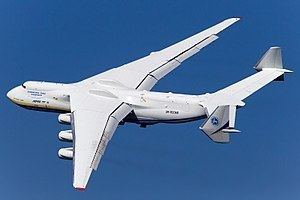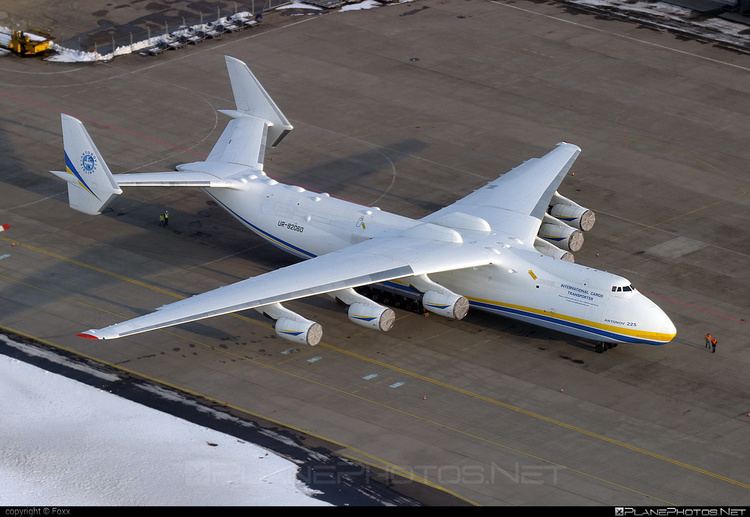Length 84 m Weight 285,000 kg Engine type Progress D-18T | Top speed 850 km/h Range 15,400 km Manufacturer Antonov | |
 | ||
Unit cost 200,000,000–250,000,000 USD (2013) Similar Antonov An 74, Antonov An 26, Antonov An 72 | ||
Antonov an 225 mriya strategic airlift cargo aircraft
The Antonov An-225 Mriya (Ukrainian: Антонов Ан-225 Мрія (dream or inspiration), NATO reporting name: "Cossack") is a strategic airlift cargo aircraft that was designed by the Antonov Design Bureau in the Soviet Union in the 1980s. It is powered by six turbofan engines and is the longest and heaviest airplane ever built, with a maximum takeoff weight of 640 tonnes (710 short tons). It also has the largest wingspan of any aircraft in operational service. The single example built has the Ukrainian civil registration UR-82060. A second airframe with a slightly different configuration was partially built. Its construction was halted in 1994 because of lack of funding and interest, but revived briefly in 2009, bringing it to 60%-70% completion. On 30 August 2016, Antonov agreed to complete the second airframe for Aerospace Industry Corporation of China as a prelude to AICC commencing series production.
Contents
- Antonov an 225 mriya strategic airlift cargo aircraft
- Antonov an 225 mriya is a strategic airlift cargo aircraft
- Development
- Design
- Operational history
- Antonov commercialization
- Regular commercial flights
- Operators
- Specifications An 225 Mriya
- References

The Antonov An-225, initially developed for the task of transporting the Buran spaceplane, was an enlargement of the successful Antonov An-124. The first and only An-225 was completed in 1988. After successfully fulfilling its Soviet military missions, it was mothballed for eight years. It was then refurbished and re-introduced, and is in commercial operation with Antonov Airlines carrying oversized payloads. The airlifter holds the absolute world records for an airlifted single-item payload of 189,980 kilograms (418,830 pounds), and an airlifted total payload of 253,820 kg (559,580 lb). It has also transported a payload of 247,000 kg (545,000 lb) on a commercial flight.

Antonov an 225 mriya is a strategic airlift cargo aircraft
Development

The Antonov An-225 was designed to airlift the Energia rocket's boosters and the Buran orbiter for the Soviet space program. It was developed as a replacement for the Myasishchev VM-T. The An-225's original mission and objectives are almost identical to that of the United States' Shuttle Carrier Aircraft.

The An-225 first flew on 21 December 1988 with a 74-minute flight from Kiev. The aircraft was on static display at the Paris Air Show in 1989 and it flew during the public days at the Farnborough air show in 1990. Two aircraft were ordered, but only one An-225 (registration CCCP-82060 later UR-82060) was finished. It can carry ultra-heavy and oversize freight, up to 250,000 kg (550,000 lb) internally, or 200,000 kg (440,000 lb) on the upper fuselage. Cargo on the upper fuselage can be 70 m (230 ft) long.

A second An-225 was partially built during the late 1980s for the Soviet space program. Following the collapse of the Soviet Union in 1991 and the cancellation of the Buran space program, the lone operational An-225 was placed in storage in 1994. The six Ivchenko-Progress engines were removed for use on An-124s, and the second uncompleted An-225 airframe was also stored. The first An-225 was later re-engined and put into service.
By 2000, the need for additional An-225 capacity had become apparent, so the decision was made in September 2006 to complete the second An-225. The second airframe was scheduled for completion around 2008, then delayed. By August 2009, the aircraft had not been completed and work had been abandoned. In May 2011, the Antonov CEO is reported to have said that the completion of a second An-225 Mriya transport aircraft with a carrying capacity of 250 tons requires at least $300 million, but if the financing is provided, its completion could be achieved in three years. According to different sources, the second jet is 60–70% complete.
In April 2013, the Russian government announced plans to revive Soviet-era air launch projects that would use a purpose-built modification to the An-225 as a midair launchpad.
In August 2016, representatives from Ukraine's Antonov and Aerospace Industry Corporation of China, an import-export company operating out of Hong Kong, signed an agreement to recommence production of the An-225, with China now planning to procure and fly the first model by 2019. The aviation media cast doubt on the production restart, indicating that due to the ongoing Russia–Ukraine conflict needed parts from Russia are unavailable, although they may be made in China instead.
Design
Based on Antonov's earlier An-124, the An-225 has fuselage barrel extensions added fore and aft of the wings. The wings also received root extensions to increase span. Two more Progress D-18T turbofan engines were added to the new wing roots, bringing the total to six. An increased-capacity landing gear system with 32 wheels was designed, some of which are steerable, enabling the aircraft to turn within a 60 m-wide (200 ft) runway. Like its An-124 predecessor, the An-225 has nose gear designed to kneel so cargo can be more easily loaded and unloaded. Unlike the An-124, which has a rear cargo door and ramp, the An-225 design left these off to save weight, and the empennage design was changed from a single vertical stabilizer to a twin tail with an oversized horizontal stabilizer. The twin tail was essential to enable the plane to carry large, heavy external loads that would disturb the airflow around a conventional tail. Unlike the An-124, the An-225 was not intended for tactical airlifting and is not designed for short-field operation.
Initially the An-225 had a maximum gross weight of 600 t (660 short tons), but from 2000 to 2001 the aircraft underwent modifications at a cost of US$20M such as the addition of a reinforced floor, which increased the maximum gross weight to 640 t (710 short tons).
Both the earlier and later takeoff weights establish the An-225 as the world's heaviest aircraft, being heavier than the double-deck Airbus A380. It is surpassed in other size-related categories, however: Airbus claims to have improved upon the An-225's maximum landing weight by landing an A380 at 591.7 tonnes (1,304,000 lb) during tests, and the Hughes H-4 Hercules, known as the "Spruce Goose", has a greater wingspan and a greater overall height. But the Spruce Goose is 20% shorter and overall lighter, due to the materials used in its construction. It only flew once, making the An-225 the largest aircraft in the world to fly multiple times.
The An-225's pressurized cargo hold is 1,300 m3 (46,000 cu ft) in volume; 6.4 m (21 ft 0 in) wide, 4.4 m (14 ft) high, and 43.35 m (142 ft 3 in) long — longer than the first flight of the Wright Flyer.
Operational history
During the last years of the Soviet space program, the An-225 was employed as the prime method of transporting the Buran space shuttle.
Antonov commercialization
In the late 1980s, the Soviet government was looking to generate revenue from its military assets. In 1989, the Antonov Design Bureau set up a holding company as a heavy airlift shipping corporation under the name "Antonov Airlines", based in Kiev, Ukraine and operating from London Luton Airport in partnership with Air Foyle HeavyLift.
The company began operations with a fleet of four An-124-100s and three Antonov An-12s, but a need for aircraft larger than the An-124 became apparent in the late 1990s. In response, the original An-225 was re-engined, modified for heavy cargo transport, and placed back in service under the management of Antonov Airlines.
On 23 May 2001, the An-225 received its type certificate from the Interstate Aviation Committee Aviation Register (IAC AR). On 11 September 2001, carrying four main battle tanks at a record load of 253.82 tonnes (279.79 short tons) of cargo, the An-225 flew at an altitude of up to 10,750 m (35,270 ft) over a closed circuit of 1,000 km (620 mi) at a speed of 763.2 km/h (474.2 mph).
Regular commercial flights
The type's first flight in commercial service departed from Stuttgart, Germany on 3 January 2002, and flew to Thumrait, Oman with 216,000 prepared meals for American military personnel based in the region. This vast number of ready meals was transported on 375 pallets and weighed 187.5 tons.
The An-225 has since become the workhorse of the Antonov Airlines fleet, transporting objects once thought impossible to move by air, such as 150-tonne generators. It has become an asset to international relief organizations for its ability to quickly transport huge quantities of emergency supplies during disaster relief operations.
The An-225 has been contracted by the Canadian and U.S. governments to transport military supplies to the Middle East in support of coalition forces. An example of the cost of shipping cargo by An-225 was over 2 million DKK (approx. €266,000) for flying a chimney duct from Billund, Denmark to Kazakhstan in 2004.
On 11 August 2009, the heaviest single cargo item ever sent via air freight was loaded onto the An-225. At 16.23 m (53.2 ft) long and 4.27 m (14.0 ft) wide, its consignment, a generator for a gas power plant in Armenia along with its loading frame, weighed in at a record 189 tonnes (417,000 lb).
During 2009, the An-225 was painted in a new blue and yellow paint scheme, after Antonov ceased cooperation with AirFoyle and partnered with Volga-Dnepr in 2006.
On 11 June 2010, the An-225 carried the world's longest piece of air cargo, two 42.1 m (138 ft) test wind turbine blades from Tianjin, China to Skrydstrup, Denmark.
Operators
Specifications (An-225 Mriya)
Data from Vectorsite, Antonov's Heavy Transports, and others
General characteristics
Performance
